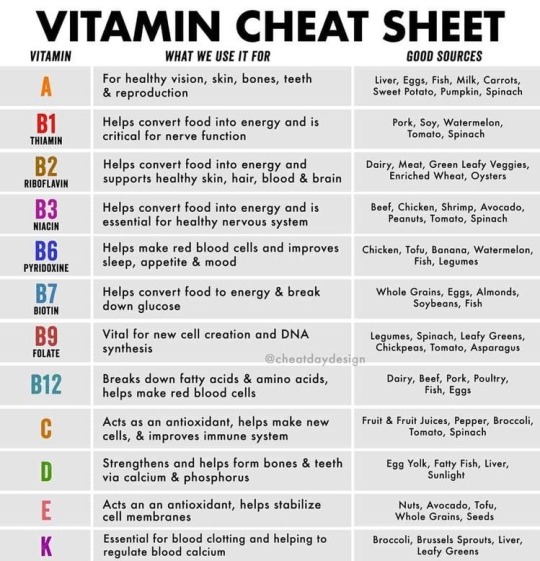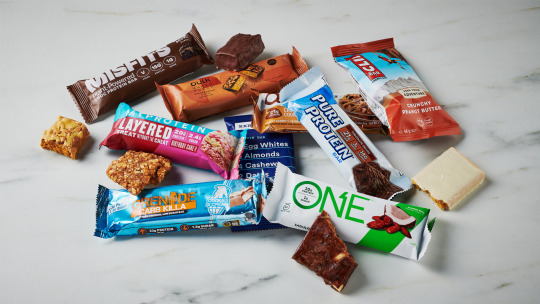#nutrients
Text
Superfoods you should incorporate in your diet:
Superfoods are nutrient-dense foods that are considered beneficial for your health due to their high concentration of vitamins, minerals, antioxidants, and other beneficial compounds.
Combine these superfoods with a variety of other whole foods to ensure you're getting a wide range of nutrients. Also, be mindful of portion sizes and any individual dietary restrictions or allergies you may have.
Berries: Blueberries, strawberries, raspberries, and other berries are rich in antioxidants, fiber, and vitamins.
Leafy greens: Spinach, kale, Swiss chard, and other leafy greens are packed with vitamins, minerals, and fiber. They are low in calories and provide important nutrients like vitamin K, vitamin C, and folate.
Cruciferous vegetables: Broccoli, cauliflower, Brussels sprouts, and cabbage are part of the cruciferous vegetable family. They contain compounds that may help reduce the risk of certain cancers.
Nuts and seeds: Almonds, walnuts, chia seeds, flaxseeds, and hemp seeds are excellent sources of healthy fats, protein, fiber, and various vitamins and minerals.
Fish: Fatty fish like salmon, sardines, and mackerel are rich in omega-3 fatty acids, which are beneficial for heart health and brain function.
Whole grains: Quinoa, brown rice, oats, and whole wheat are examples of whole grains that provide fiber, vitamins, and minerals.
Legumes: Beans, lentils, chickpeas, and other legumes are high in fiber, protein, and various nutrients. They are also a good source of plant-based protein.
Turmeric: This spice contains curcumin, a compound with potent anti-inflammatory and antioxidant properties.
Green tea: Green tea is rich in antioxidants called catechins and is believed to have various health benefits, including improved brain function and a lower risk of certain diseases.
Dark chocolate: Dark chocolate with a high cocoa content (70% or higher) is a source of antioxidants and may have positive effects on heart health and mood.
Avocado: Avocados are rich in healthy fats, fiber, and various vitamins and minerals. They also provide a good source of potassium.
Greek yogurt: Greek yogurt is a protein-rich food that also contains beneficial probiotics, calcium, and vitamin B12.
Sweet potatoes: Sweet potatoes are packed with vitamins, minerals, and fiber. They are an excellent source of beta-carotene, which is converted into vitamin A in the body.
Garlic: Garlic contains sulfur compounds that have been associated with potential health benefits, including immune support and cardiovascular health.
Ginger: Ginger has anti-inflammatory properties and is commonly used to aid digestion and relieve nausea.
Seaweed: Seaweed, such as nori, kelp, and spirulina, is a rich source of minerals like iodine, as well as antioxidants and omega-3 fatty acids.
Pomegranate: Pomegranates are packed with antioxidants and are believed to have anti-inflammatory properties. They are also a good source of vitamin C and fiber.
Cacao: Raw cacao is the purest form of chocolate and is rich in antioxidants, flavonoids, and minerals. It can be enjoyed as nibs, powder, or in dark chocolate form.
Quinoa: Quinoa is a gluten-free grain that provides a complete source of protein, along with fiber, vitamins, and minerals.
Extra virgin olive oil: Olive oil is a healthy fat option, particularly extra virgin olive oil, which is high in monounsaturated fats and antioxidants.
Chia seeds: Chia seeds are a great source of fiber, omega-3 fatty acids, and antioxidants. They can be added to smoothies, yogurt, or used as an egg substitute in recipes.
Beets: Beets are rich in antioxidants and are known for their vibrant color. They also contain nitrates, which have been shown to have beneficial effects on blood pressure and exercise performance.
Matcha: Matcha is a powdered form of green tea and is known for its high concentration of antioxidants. It provides a calm energy boost and can be enjoyed as a tea or added to smoothies and baked goods.
Algae: Algae, such as spirulina and chlorella, are nutrient-dense foods that are rich in protein, vitamins, minerals, and antioxidants. They are often consumed in powdered or supplement form.
Fermented foods: Fermented foods like sauerkraut, kimchi, kefir, and kombucha are rich in beneficial probiotics that support gut health and digestion.
Maca: Maca is a root vegetable native to the Andes and is often consumed in powdered form. It is known for its potential hormone-balancing properties and is commonly used as an adaptogen.
Goji berries: Goji berries are small red berries that are rich in antioxidants, vitamins, and minerals. They can be enjoyed as a snack or added to smoothies and oatmeal.
Hemp seeds: Hemp seeds are a great source of plant-based protein, healthy fats, and minerals like magnesium and iron. They can be sprinkled on salads, yogurt, or blended into smoothies.
Moringa: Moringa is a nutrient-dense plant that is rich in vitamins, minerals, and antioxidants. It is often consumed as a powder or used in tea.
Mushrooms: Certain mushrooms, such as shiitake, reishi, and maitake, have immune-boosting properties and are rich in antioxidants. They can be cooked and added to various dishes.
#health tips#healthy lifestyle#health and wellness#nutrients#healthy life tips#healthy life hacks#healthy diet#level up journey#high value mindset#health is wealth#levelupjourney#glow up tips#glow up#nutrition#healthy living
2K notes
·
View notes
Text

#vitamins#nutrients#healthy#healthy food#healthy eating#eat well#fitblr#fitness#weight loss#weight loss journey#fitspiration#health & fitness#motivation
384 notes
·
View notes
Text

...no doubt spinach...
#vegetable#vegetables#healthy#eating healthy#nutrition#nutrients#nutrient#vodka#chip#fries#potatoes#potato
131 notes
·
View notes
Text

Beauty From The Inside Out
#wellness#skin care#self care#nutrition#beauty#health#health and wellness#health and beauty#health and fitness#self healing#healingjourney#healthy#healthy living#healthy eating#healthy food#exercise#nutrients#nutritious#super food#healthy fruits#fruit#fruits and vegetables#fresh fruit#breakfast#lunch#biophilia#biophilia nutrition#biophilianutrition#superfoods#fruits
39 notes
·
View notes
Text
If ya think about it... rocks are just inaccessible nutrients that water helps break down over time, which then can be accessed by plant roots and the delivered to us or other animals as edible nutrients.
Plants are just catalysts to help us eat rocks.
#keep it green#rhizosphere#mycelium#evolution#lignin#plants#plant life#biology#geology#rhizome#soil web#op#ovrgrwn#rocks#nutrients#building blocks of life#honestly bro#this planet is absolutely magnificent
185 notes
·
View notes
Text

Understanding FDA Guidance: "Excellent Source of Fiber" and "Good Source of Fiber"
Welcome to fitscientist! I'm a food scientist irl and I see a lot of misconceptions about packaging claims out there - I'm trying to be more active on my tumblr (instead of just reblogging/queuing pretty pictures - which obviously I will continue to do!!) and I'd like to share my expertise with you all so we're all more knowledgeable about food labeling, packaging, and more - especially as we are all on our fitness journies together :) The more you know!
Today, we'll be discussing the FDA's guidance on "Excellent Source of Fiber" and "Good Source of Fiber" claims found on food packaging. Understanding these claims can help you make informed choices when selecting products that contribute to your daily fiber intake. Let's dive in!
FDA Guidance on "Excellent Source of Fiber" and "Good Source of Fiber"
The FDA has established specific criteria for food manufacturers to use the terms "Excellent Source of Fiber" and "Good Source of Fiber" on their packaging. These claims are intended to inform consumers about the fiber content of a particular food product.
Here's a breakdown of the FDA's guidance:
1. "Excellent Source of Fiber":
- To make an "Excellent Source of Fiber" claim, a food product must contain at least 20% of the Daily Value (DV) for fiber per serving.
- The DV for fiber is 28 grams per day based on a 2,000 calorie diet.
- Therefore, a food item must contain at least 5.6 grams of fiber per serving to qualify as an "Excellent Source of Fiber."
2. "Good Source of Fiber":
- To make a "Good Source of Fiber" claim, a food product must contain at least 10% of the DV for fiber per serving.
- This means the food item should contain at least 2.8 grams of fiber per serving.
It's important to note that these claims are based on the fiber content per serving of the food product. Different products may have varying serving sizes, so it's crucial to check the serving size stated on the packaging to accurately gauge the fiber content you'll be consuming.
Why Fiber is Important (as covered in a previous post, but a reminder on why fiber is important for our health!):
- Fiber aids in digestion, promoting regular bowel movements and preventing constipation.
- It helps control appetite by keeping us feeling full for longer periods, which can support weight management goals.
- Fiber plays a role in regulating blood sugar levels, making it beneficial for individuals with diabetes or those aiming for stable energy levels.
- A high-fiber diet has been linked to a reduced risk of heart disease and improved cardiovascular health.
When shopping for food products, the "Excellent Source of Fiber" and "Good Source of Fiber" claims can be helpful indicators of a product's fiber content. By understanding the FDA's guidance, you can make informed choices to meet your daily fiber needs. Remember to check the serving size and consider incorporating a variety of fiber-rich foods into your diet for optimal health benefits. Stay nourished and enjoy a fiber-filled lifestyle!
Disclaimer: The information provided in this blog post is for educational purposes only and should not replace professional medical advice nor guidance for front-of-pack labeling claims. Please consult with a healthcare professional or registered dietitian for personalized dietary recommendations, and consult with a regulatory professional for guidance on product content or other claims for your own products.
#informational#health#nutrition#fitblr#fitfam#fitness#fitblrs#running#food#fitspo#workout#weightlifting#gym motivation#healthy food#healthy living#healthyfood#healthy eating#nutrients#healthy#fiber#fiber intake#soluble fiber#insoluble fiber#public health#personal#my post#personal fitblr#healthy lifestyle#healthy diet#food packaging
33 notes
·
View notes
Text

#mind#body#soul#positive#positivity#happiness#joy#love#self love#self care#health#healthy#food#inspiration#inspiring quotes#inspiring words#motivation#nutrition#nutrients#cooking#quotes#feel good#manifestation#spirituality#happiness quotes#happy#healthy living#fitness#mind body spirit#mind body soul
17 notes
·
View notes
Note
Lucca eu perdi muito peso já desde quando comecei aqui, mas não vejo muita diferença no meu corpo, só pescoço, pernas (a parte da virilha nem tanto) e costas, queria perder mais cintura mas por mais que eu me exercite todos os dias ainda assim não afina, tem alguma dica? Tenho q comer mais proteína pra perder gordura corporal?
Oioi, anon
Emagrecimento é um processo demorado, mesmo que você não tenha perdido tudo o que deseja, você está perdendo algo, então não desanime!
Quem perdeu 20kg começou perdendo 1!
.
Sobre afinar a cintura eu não tenho exercícios pra te recomendar, mas quanto a perca de gordura você deve sim focar em proteína!
Perder gordura -> comer menos (déficit calórico) + muita proteína (cerca de 1,4-1,8g por kg) + cardio
Mesmo com exercícios, sem uma dieta balanceada você perderá apenas peso, não necessariamente gordura🤷🏻♂️
Sabe aquela impressão de que seu tamanho reduziu, mas você está "fofinha", não fica sequinha, sabe? É o tão temido skinnyfat klkkk por isso é importante termos uma boa alimentação ☝🏻
Espero ter ajudado!
18 notes
·
View notes
Text
Thinking about the kids at Camp Here And There and their nutrient deficiency. Like. “Vegans get jello!” ?!! They’re kids!!! Only that for dinner?!!
#adding an#unreality#tag just in case people take this too seriously#camp here and there#is a fictive podcast#fictional podcast#podcast#heart hands#nutrients#food
16 notes
·
View notes
Text
I’m gonna share another very useful approach to life as an adult with ADHD: cooking and nutrition edition.
The American idea that dinner is “meat/protein with a veggie and a side” and that this is somehow an easy thing to prepare is a lie. That’s so much work. Sometimes I like making a meal that requires a lot of effort but that’s not sustainable for my average weeknight dinner.
I would like to instead introduce you to my world of Sauce Based Cooking. It is predicated on the idea that the “one pan meal” is not a category of recipe but rather a decision made by the chef. There are some deviations (some meals require a pasta pot and/or sheet pan) but that’s still way less than a lot of recipes call for. If it requires a blender, simply close the link and step away.
Rules for Sauce Based Cooking Freedom:
Have more spices/flavorful pastes than you know what to do with. Better than Bouillon and miso paste and curry paste and spice mixes etc etc. You are not running an authentic Tex-Mex restaurant from your kitchen just get the taco seasoning packets.
If you eat meat, you should be buying bone-in skin-on chicken thighs. Not chicken breasts. You can braise a chicken thigh for two hours and it will only get tastier and better. Cooking a chicken breast is stressful and requires a level of precision im not prepared to give to a chicken.
Focus on learning to make tasty BASES. You have learned if you make it and it tastes good to you. Nail down a good cream sauce, perfect your 20 minute marinara, learn a coconut curry, figure out the basic components of a marinade. Add some ground ginger to your chicken soup and thank me later. Then cooking is just beating protein and veggies into submission under your sauces and above your grains.
Don’t try and make ~dishes~. I call this “Zelda cooking.” You need something that you enjoy eating and gives you the nutrients you need to function. Prep vegetables and proteins you like and dump them into a sauce you also like. Add some polenta or bread or rice or couscous or any other grain to soak up the sauce and make it filling and satisfying. 9 times out of 10 it’s gonna work. The only decision you need to make is the flavor profile of the sauce.
Buy the precut vegetables. I know. It feels wasteful. So much plastic. But I promise you it’s way more wasteful to throw out half your groceries and order Uber eats 5 days in a row because you never managed to chop an onion. It’s okay. Precut/frozen vegetables and canned ingredients and prepared food items are going to be your lifeline. I can turn a rotisserie chicken and plastic tub of mirepoix (pre chopped onions, celery and carrots) into a delectable soup with just things in my pantry at this very moment.
Same as above but line the pan with foil. Save yourself a dish.
Add at least one vegetable to everything you cook. This might be controversial but you need fiber. And all sorts of other vitamins and minerals that things like kale and carrots and sweet potatoes have. My go to is canned chickpeas. A jar of marinara plus some canned chickpeas and kale is suddenly a hearty and filling topping for pasta that’s gonna satisfy me way more than just the pasta and sauce. And all I had to do was dump a can and a bag into the pot. That’s not a dish that really exists or has a recipe but it’s Sauce Based and I eat it a lot.
Keep some fortified cereal (most cereal is fortified by default) and trail mix on hand. Sometimes I get in a funk and order a lot of takeout or just eat a lot of carbs and not much else and then get woozy because I’m a little dumb and don’t eat a lot of animal products so all my Nutrients are low and that makes cooking harder. Fortified cereal and trail mix together will have most of the stuff you need to get rid of the lightheaded wooziness (iron and b12 and fats and sugar) in a dense little package that’s easy to munch on while cooking.
Finally, I know online recipes and Pinterest are great and wonderful but get proper cookbooks whenever you can. The first reason is that even with AdBlocker online recipes are a minefield and can be distracting and frustrating and overwhelming which are all things you don’t want when knives and hot pans are around. The second is that you will learn so much about cooking from a proper cookbook and the better you are at cooking the easier and faster it goes. ThriftBooks has plenty as will your local library or even older relatives. Ones like “Cook What You Have” by Christopher Kimball and “The New York Times Cooking No-Recipe Recipes” book and the classic “The Art of Simple Food” by Alice Waters are great.
#adhd advice#adhd tips#adhd adult#living with adhd#cooking#food#nutrition#nutrients#adhd nutrition#cooking tips#cooking advice
20 notes
·
View notes
Text
if no one got me I know peanut butter got me
6 notes
·
View notes
Text

Energy
#wellness#skin care#self care#beauty#nutrition#supplements#nutrients#vitamins#healthy#healthy lifestyle#health#health and wellness#health and fitness#health and beauty#self healing#healingjourney#healing#wellness routine#makeup#eye makeup#eye shadow#biophilia#biophilia nutrition#biophilianutrition
30 notes
·
View notes
Text

Understanding FDA Guidance on Protein Claims: Demystifying "Excellent Source" and "Good Source"
Welcome to fitscientist! I'm a food scientist irl and I see a lot of misconceptions about packaging claims out there - I'm trying to be more active on my tumblr (instead of just reblogging/queuing pretty pictures - which obviously I will continue to do!!) and I'd like to share my expertise with you all so we're all more knowledgeable about food labeling, packaging, and more - especially as we are all on our fitness journies together :) The more you know!
Today, let's dive into the fascinating world of FDA guidance for protein claims. Yeah yeah, we all know protein is good for you, but when you look at a food label, do you really know what you're getting?
We often come across terms like "excellent source of protein" and "good source of protein" on food labels, but what do these claims really mean? Let's break it down:
1. Excellent Source of Protein: - According to the FDA, a food product can be labeled as an "excellent source of protein" if it provides 20% or more of the Daily Value (DV) for protein per serving. This means that consuming a serving of such a product can significantly contribute to meeting your protein needs for the day.
2. Good Source of Protein: - A food product can be labeled as a "good source of protein" if it provides 10-19% of the DV for protein per serving. While not as high as an excellent source, choosing foods labeled as good sources of protein can still contribute to your daily protein requirements.
It's important to note that these claims are based on the protein content per serving of the food product. Different products may have varying serving sizes, so it's crucial to check the serving size stated on the nutrition facts panel to accurately gauge the protein content you'll be consuming.
3. Daily Value (DV): - The DV is a standard reference set by the FDA, representing the recommended daily intake of a nutrient, including protein, based on a 2,000-calorie diet. For protein, the DV is set at 50 grams per day, which can vary depending on individual needs.
4. Consider Your Individual Needs: - It's important to remember that individual protein needs may differ based on factors like age, sex, activity level, and overall health. While these claims can help guide your choices, it's essential to assess your personal protein requirements in consultation with a healthcare professional or registered dietitian.
5. Protein Quality Matters: - While the FDA guidance focuses on the quantity of protein, it's equally important to consider the quality of the protein you consume. Complete proteins are those that contain all essential amino acids required for muscle repair and growth. Look for sources like lean meats, poultry, fish, eggs, dairy, and plant-based complete proteins like quinoa and soy.
Remember, protein is a vital macronutrient necessary for several bodily functions, including muscle repair, satiety, and hormone regulation. By understanding the FDA's guidance, you can make informed choices to meet your daily protein needs. Remember to check the serving size and consider incorporating a variety of protein-rich foods into your diet for optimal health benefits. Stay nourished! <3
Disclaimer: The information provided in this blog post is for educational purposes only and should not replace professional medical advice nor guidance for front-of-pack labeling claims. Please consult with a healthcare professional or registered dietitian for personalized dietary recommendations, and consult with a regulatory professional for guidance on product content or other claims for your own products.
#fitblr#food#fitness#health#informational#protein#high protein#healthy#nutrition#healthy eating#nutrients#healthy recipes#recipe#recipes#runblr#running#weight lifting#gym#gymlife#weightlifting#powerlifting#gym motivation#workout#gymbabe#gymmotivation#FDA#protein claims#excellent source of protein#fitfam#fit life
25 notes
·
View notes

